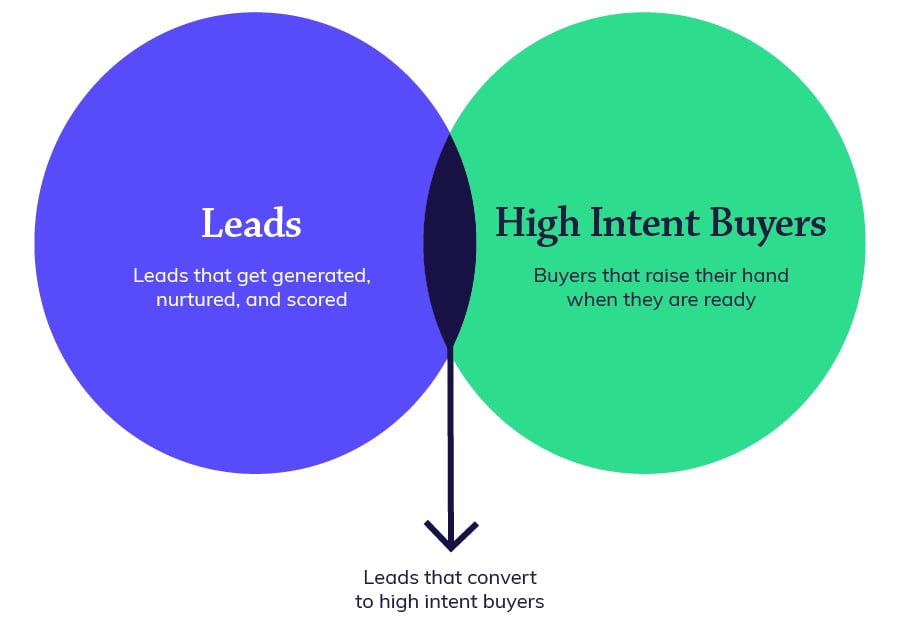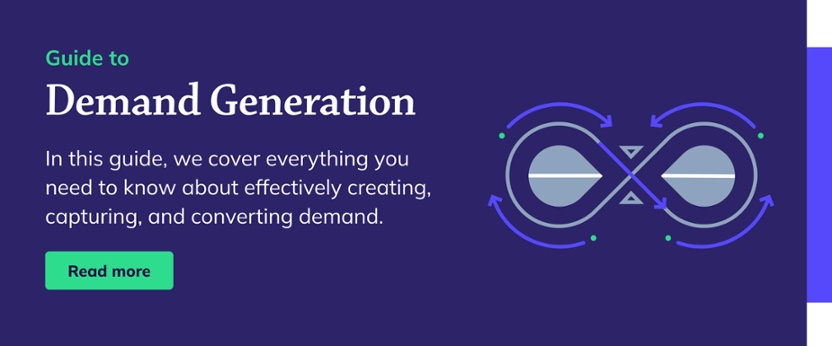With lead generation proving less effective than ever, many marketers are turning to demand generation as a new go-to-market approach. However, making a successful transition can be challenging.
In this article, we break down how to make the shift from both strategic and tactical perspectives and address the reasons why some marketers struggle to pivot effectively.
What's the problem with lead generation?
Marketers are re-evaluating the effectiveness and value of their marketing strategies as businesses seek better ROI.
This has resulted in the realisation that lead generation is a costly and inefficient method of converting prospects into customers.
Marketers are discovering that the buyers who actually convert into paying customers rarely go through the 'lead generation' process. Instead, they remain entirely anonymous until the point they explicitly declare interest in a solution.

This shift in behaviour is down to the frustration that buyers feel towards traditional lead generation tactics, such as:
- Cold calls from sales
- Lead nurturing email spam
- Unsolicited LinkedIn messages
- Other outbound interruption
Serious buyers understand the consequences of giving away their personal information. So, they're intentionally staying anonymous to avoid becoming targets of unwanted marketing efforts. By avoiding the lead generation process until they're ready to engage with a company, they maintain control over their own buying journey.
Why are marketers pivoting to demand generation?
Marketers who have recognised the limitations of their lead generation strategy are seeing the benefits of a demand generation approach.
The main benefit is that (inbound) demand generation perfectly aligns with today's complex buyer journeys. It creates a clear path to purchase that's free of frustration and aligned to the buyer's preferences.
Focusing on demand generation means marketers can create helpful content that reaches a wider audience and encourages consumption without requiring personal details. This fosters affinity with your brand, establishes trust, and increases the likelihood of customers choosing the brand over competitors.
How to make the pivot from a strategic level
There are three stages to pivoting from lead generation to demand generation:
Stage 1: Engaging stakeholders
The first stage in pivoting from lead generation to demand generation is to bring your marketing team together and ensure that everyone's committed to making the shift. This involves open and honest communication about the limitations of the current lead generation strategy and the need for a new approach. It's essential to have clarity across the marketing function.
Once you're all aligned, start to dig into the data and analyse the effectiveness of your lead generation campaigns. The best way to do this is through a split funnel analysis.
After you've uncovered the poor results from your lead generation efforts, it's time to rally the troops. This means presenting your findings back to stakeholders, outlining the issues with your current approach, and highlighting the need for change.
This can take lots of conversations and back and forth, but it's critical that everybody's on board and recognises the need for a new approach.
Stage 2: Planning the pivot
Once you've rallied stakeholders and have initial buy-in on the pivot, it's time to plan your transition. Working with a proven b2b demand generation agency at this point can help ensure you're covering all bases, but here are the things to plan for.
Website changes
A demand generation website is different to a lead generation website. You need to plan how you'll optimise user experience (UX) for high-intent conversions, refine your messaging, and improve the website/sales handoff process.
Content strategy changes
In addition to website updates, you'll need to plan the changes you need to make to your content strategy, including:
- How you'll ungate your content
- Your new content creation framework
- Where you'll distribute content
- The formats you'll use
Ongoing measurement
It's important to define the key metrics that you'll measure going forward to track the success of your demand generation efforts. And importantly, what you're not going to measure to define success.
Resource gaps
During the planning stage, it's crucial to identify any skills and resources that your team currently lacks and needs to acquire. Whether it's hiring new team members, outsourcing certain tasks, or investing in training and development, ensuring that you have the necessary expertise and resources is vital for a successful pivot to demand generation.
The impact on sales
Moving from lead generation to demand generation will have a knock-on effect on the sales team. They'll receive fewer low-intent leads that they need to try and sell to. Instead, they'll receive a lower number of leads overall, but they'll be higher-intent and closer to purchase. Work with sales leaders to plan how to use the additional sales resources and time going forward.
Document and present
Document these changes and prepare a comprehensive presentation that outlines what you'll stop doing, what you will do instead, and the expected impact of these changes.
Once you've finalised your plan, communicate it to stakeholders and ensure everyone's on the same page and aligned with the new direction.
Stage 3: Executing the pivot
With the plan in place, it's time to execute the necessary updates you've outlined. This means putting your plan into action and making tactical changes.
How to make the pivot at a tactical level
When making the pivot from lead generation to demand generation, it's good practice to prioritise the elements that are closest to your pipeline. After all, there's no point in creating new demand if you can't effectively capture and convert it.
Step 1: Optimise your website for demand generation
Focus on optimising your website to ensure that:
- You've designed the site architecture with SEO in mind. This means that potential buyers can easily find you through relevant commercial-intent keywords.
- It has an intuitive user experience (UX). This is essential in guiding visitors to the most important information at each stage of their buyer's journey.
- All your call-to-actions (CTAs) align around the same goal of high-intent conversions. This means ditching the traditional eBook download CTAs and driving people towards actions that truly reflect your desired outcome such as trials, demos, and meetings with sales.
- You have a seamless handoff process between your website and sales process. This is vital to ensure a quick follow-up and increase the chance of converting a lead into a customer.
Step 2: Change your content strategy
Moving from gated to ungated content
It's time to move away from gated content and transition towards ungated content. This approach makes it easier to access and consume, enabling you to reach a wider audience.
The easiest way to get started is to take your gated content, such as guides, eBooks, whitepapers etc., and organise it into content clusters. This can take the typical hub and spoke content structure, where content within the same topics is interlinked for greater SEO benefit. From here, convert the gated content into website pages optimised around the topical keywords you want to rank for.
This quick and simple tactic makes it easy for people to find your once-gated content in search.
Producing new content
As you transition to a demand generation approach, start producing new content with an ungated-first mindset. This means prioritising content consumption over conversions. Research the channels your target audience uses, identify the formats that resonate with them, and craft messages that align with their interests and needs.
Once you understand what you need to create, produce a framework that allows you to sustainably create and repurpose your content in the necessary formats.
Content distribution strategy
After creating valuable content, it's important to distribute it effectively. Align your content distribution efforts with demand generation strategies by prioritising consumption over conversion. This means focusing on getting your content in front of your target audience through channels they regularly engage with.
Step 3: Review your PPC strategy and spend
When it comes to advertising, shift your Google PPC (Pay-Per-Click) campaigns towards high-intent queries. By targeting buyers who are actively looking for solutions, you can maximise your budget and increase the chances of conversion. On the other hand, use social ads to target in-feed consumption. This approach allows you to seamlessly integrate your content into users' social media feeds, capturing their attention and generating interest.
Step 4: Implementing attribution and measurement
Finally, make sure to measure the right metrics and implement the necessary technology to track your success. This includes adding self-reported attribution to your website and creating dashboards and reports to monitor the effectiveness of your demand-generation efforts. By measuring the right things, you can gain valuable insights into the impact of your strategies and make data-driven decisions to optimise your campaigns.
Step 5: Allocate demand generation resources
Restructuring your team and getting the necessary support is a crucial step in successfully sustaining and improving your demand generation approach. This means identifying any skill and resource gaps within your team and taking the necessary steps to fill them either through hiring or getting external support from agencies.
Why marketers struggle to make the pivot
Lots of marketers agree that they need to make the pivot from lead generation to demand generation, but why are some struggling to execute it?
1. Misalignment with sales
One of the main reasons for resistance is the lack of buy-in from the sales team. To transition successfully, you need a fluid shift that involves the entire company, rather than just a siloed marketing effort. Sales teams need to understand the benefits of demand generation and how it aligns with their goals. By showing them how demand generation can increase your odds of closing deals and generating revenue, they'll be more likely to support the transition.
2. Lack of evidence
Another reason for the resistance to change is the lack of evidence to get buy-in from stakeholders. Without data and metrics to support the effectiveness of demand generation (and ineffectiveness of lead generation), it can be difficult to convince decision-makers to invest in the necessary resources and strategies. Marketers need to gather and present data that demonstrates the potential impact of demand generation on lead conversion, customer acquisition cost, and overall revenue generation. By providing concrete evidence, marketers can build a stronger case for making the pivot.
3. Lack of demand generation knowledge
Additionally, many marketers may lack knowledge and understanding of demand generation. It's a relatively new way of marketing that requires a period of education and adaptation. Marketers need to familiarise themselves with the principles and strategies of demand generation. Without the right education, it can be easy for marketers to slip back into a lead generation mindset that feels more familiar.
Adopting a strategy for today's buyers
This shift isn't just a trend; it's essential for aligning your marketing efforts with the way your buyers want to research, evaluate, and make purchasing decisions in today's world.





